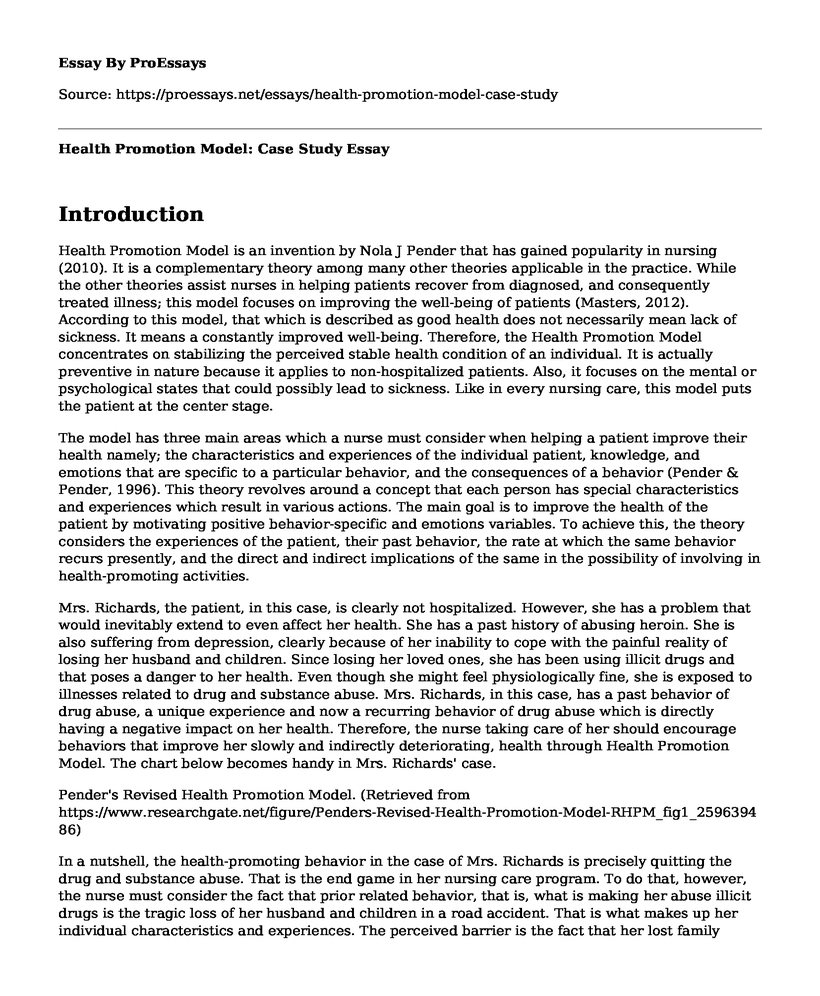Introduction
Health Promotion Model is an invention by Nola J Pender that has gained popularity in nursing (2010). It is a complementary theory among many other theories applicable in the practice. While the other theories assist nurses in helping patients recover from diagnosed, and consequently treated illness; this model focuses on improving the well-being of patients (Masters, 2012). According to this model, that which is described as good health does not necessarily mean lack of sickness. It means a constantly improved well-being. Therefore, the Health Promotion Model concentrates on stabilizing the perceived stable health condition of an individual. It is actually preventive in nature because it applies to non-hospitalized patients. Also, it focuses on the mental or psychological states that could possibly lead to sickness. Like in every nursing care, this model puts the patient at the center stage.
The model has three main areas which a nurse must consider when helping a patient improve their health namely; the characteristics and experiences of the individual patient, knowledge, and emotions that are specific to a particular behavior, and the consequences of a behavior (Pender & Pender, 1996). This theory revolves around a concept that each person has special characteristics and experiences which result in various actions. The main goal is to improve the health of the patient by motivating positive behavior-specific and emotions variables. To achieve this, the theory considers the experiences of the patient, their past behavior, the rate at which the same behavior recurs presently, and the direct and indirect implications of the same in the possibility of involving in health-promoting activities.
Mrs. Richards, the patient, in this case, is clearly not hospitalized. However, she has a problem that would inevitably extend to even affect her health. She has a past history of abusing heroin. She is also suffering from depression, clearly because of her inability to cope with the painful reality of losing her husband and children. Since losing her loved ones, she has been using illicit drugs and that poses a danger to her health. Even though she might feel physiologically fine, she is exposed to illnesses related to drug and substance abuse. Mrs. Richards, in this case, has a past behavior of drug abuse, a unique experience and now a recurring behavior of drug abuse which is directly having a negative impact on her health. Therefore, the nurse taking care of her should encourage behaviors that improve her slowly and indirectly deteriorating, health through Health Promotion Model. The chart below becomes handy in Mrs. Richards' case.
Pender's Revised Health Promotion Model. (Retrieved from https://www.researchgate.net/figure/Penders-Revised-Health-Promotion-Model-RHPM_fig1_259639486)
In a nutshell, the health-promoting behavior in the case of Mrs. Richards is precisely quitting the drug and substance abuse. That is the end game in her nursing care program. To do that, however, the nurse must consider the fact that prior related behavior, that is, what is making her abuse illicit drugs is the tragic loss of her husband and children in a road accident. That is what makes up her individual characteristics and experiences. The perceived barrier is the fact that her lost family cannot be brought back to her. The nurse should, therefore, build the patient's perceived self-efficacy by building around her a caring second family. They should keep her company and help her overcome the memories of her loved ones which are driving her into depression. This is a simultaneous invocation of interpersonal influences and breaking of the perceived barriers.
Conclusion
The situation which makes Mrs. Richards' health open to the charge of deteriorating is the loneliness which envelopes her after the demise of her family. The nurse has to; therefore, put her in a situation that encourages her well-being. This is the situational influences and includes what is moral support. The nurse can achieve this by developing a semi-formal relationship with the patient. A cultural knowledge of the patient based on the fact that she is Caucasian is handy here. In all these, the nurse should focus on keeping the patient committed to the plan of setting her free from the power of illicit drugs and ultimately improve her health.
References
Masters, K. (2012). Nursing theories: a framework for professional practice. Sudbury, MA: Jones & Bartlett Learning.
Pender, N. J., & Pender, A. R. (1996). Health promotion in nursing practice. Stamford, CT: Appleton & Lange.
Planning in Health Promotion Work. (2010). doi:10.4324/9780203842522
Cite this page
Health Promotion Model: Case Study. (2022, Apr 04). Retrieved from https://proessays.net/essays/health-promotion-model-case-study
If you are the original author of this essay and no longer wish to have it published on the ProEssays website, please click below to request its removal:
- Fetal Alcohol Spectrum Disorder
- Book Analysis of Medical Apartheid, Authored by Harriet Washington
- An Analysis of a Research Paper: Masculinity and the Persistence of AIDS Stigma
- A Childhood Dream Fulfilled: Essay Sample on My Journey to Becoming a Nurse
- Essay on 46% of US Adults Have Hypertension: Dash Diet to the Rescue
- Essay Example on Diagnosis and Treatment of Community-Acquired Pneumonia in Patients with Acute Cough
- Report Example on Legionnaires' Disease







